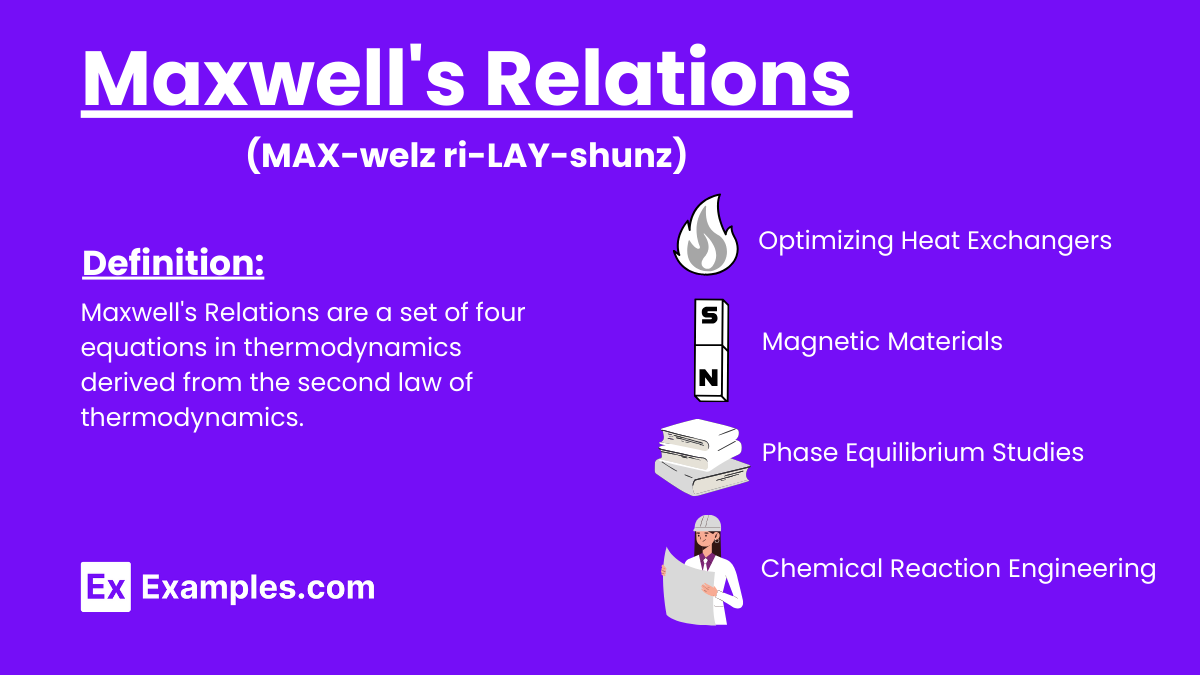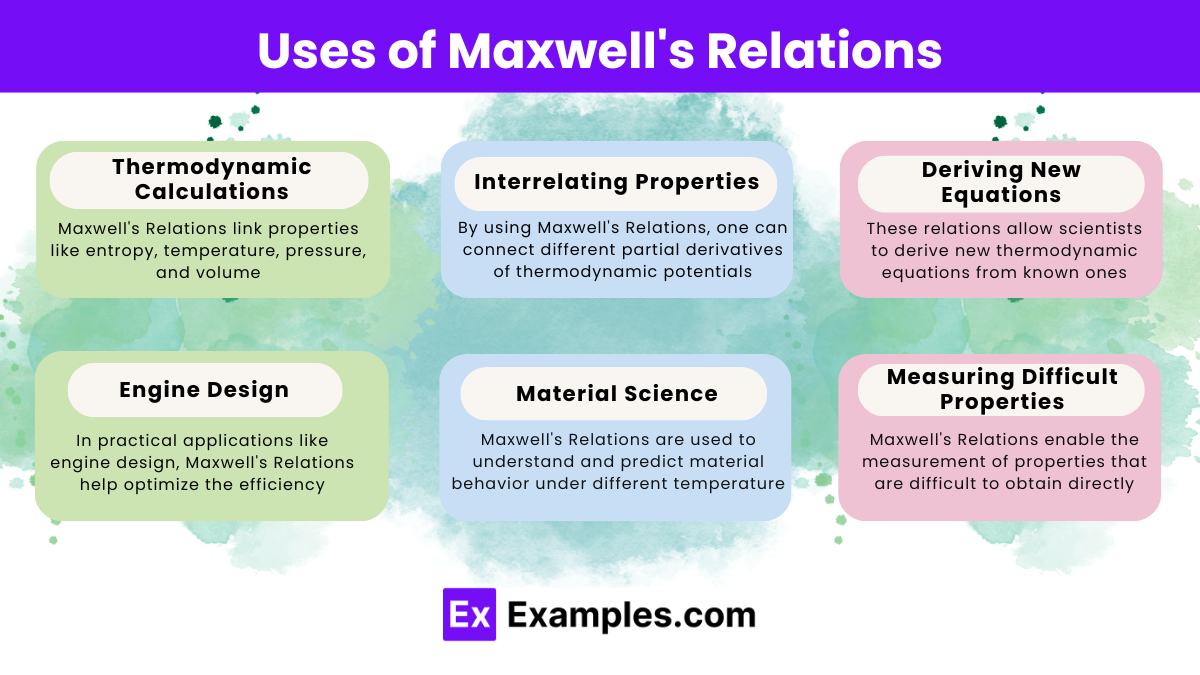What do Maxwell's relations derive from in thermodynamics?
Conservation of energy
Fundamental thermodynamic equations
Heat capacity equations
Entropy and enthalpy relations


Maxwell’s Relations are a set of four equations in thermodynamics derived from the second laws of thermodynamics. These relations are named after James Clerk Maxwell, a renowned physicist who made significant contributions to the field of thermodynamics. Maxwell’s Relations connect different partial derivatives of thermodynamic potentials, providing a powerful tool to relate various thermodynamic properties.
Maxwell’s relations can be derived as:
𝑑𝑈=𝑇𝑑𝑆−𝑃𝑑𝑉 (differential form of internal energy)
𝑑𝑈=(∂𝑧/∂𝑥)ᵧ𝑑𝑥+(∂𝑧/∂𝑦)ₓ𝑑𝑦 (total differential form)
𝑑𝑧=𝑀𝑑𝑥+𝑁𝑑𝑦 (another way of showing the equation)
𝑀=(∂𝑧/∂𝑥)ᵧ and 𝑁=(∂𝑧/∂𝑦)ₓ
From 𝑑𝑈=𝑇𝑑𝑆−𝑃𝑑𝑉:
𝑇=(∂𝑈/∂𝑆)ᵥ and −𝑃=(∂𝑈/∂𝑉)ₛ
(∂𝑧/∂𝑦)ₓ=(∂𝑀/∂𝑦)ₓ=(∂²𝑧/∂𝑦∂𝑥)=(∂²𝑧/∂𝑥∂𝑦) (symmetry of second derivatives)
(∂𝑇/∂𝑉)ₛ=(∂/∂𝑉(∂𝑈/∂𝑆)ᵥ)ₛ=(∂/∂𝑆(∂𝑈/∂𝑉)ₛ)ᵥ
(∂𝑇/∂𝑉)ₛ=−(∂𝑃/∂𝑆)ᵥ
| Function | Differential | Natural Variables | Maxwell Relation |
|---|---|---|---|
| U | 𝑑𝑈 = 𝑇𝑑𝑆−𝑃𝑑𝑉 | S, V | (∂𝑇/∂𝑉)ₛ = −(∂𝑃/∂𝑆)ᵥ |
| H | 𝑑𝐻 = 𝑇𝑑𝑆+𝑉𝑑𝑃 | S, P | (∂𝑇/∂𝑃)ₛ = (∂𝑉/∂𝑆)ₚ |
| F | 𝑑𝐹 = −𝑃𝑑𝑉−𝑆𝑑𝑇 | V, T | (∂𝑃/∂𝑇)ᵧ = (∂𝑆/∂𝑉)ₜ |
| G | 𝑑𝐺 = 𝑉𝑑𝑃−𝑆𝑑𝑇d | P, T | (∂𝑉/∂𝑇)ₚ = −(∂𝑆/∂𝑃)ₜ |
Where:
With respect to pressure and particle number, enthalpy and Maxwell’s relation can be written as:
(∂𝜇/∂𝑃)ₛ,ₙ =(∂𝑉/∂𝑁)ₛ,ₚ = (∂²𝐻/∂𝑃∂𝑁)

James Clerk Maxwell, a Scottish physicist, derived Maxwell’s Relations from the second law of thermodynamics.
Maxwell’s Relations simplify complex thermodynamic calculations by linking various properties like entropy, temperature, pressure, and volume.
They provide a way to derive new thermodynamic equations from known ones, aiding in problem-solving and theoretical development.
Maxwell’s Relations connect properties such as entropy, temperature, pressure, and volume.
They allow scientists to infer hard-to-measure properties, like entropy changes, using more accessible measurements like temperature and pressure.
They help understand phase transitions and critical points in materials, providing a framework for analyzing coexistence and transition.
Scientists use them to ensure experimental data consistency by aligning it with established thermodynamic relationships.
They aid in developing and refining thermodynamic theories and models by providing systematic approaches to study systems.
Yes, they predict volume changes with temperature in reactions at constant pressure, crucial for reactor design.
Yes, they help understand how magnetization changes with temperature, important for designing magnetic storage devices.
Text prompt
Add Tone
10 Examples of Public speaking
20 Examples of Gas lighting
What do Maxwell's relations derive from in thermodynamics?
Conservation of energy
Fundamental thermodynamic equations
Heat capacity equations
Entropy and enthalpy relations
Which of the following equations is one of Maxwell’s relations?
\left(\frac{\partial S}{\partial V}\right)_T = \left(\frac{\partial P}{\partial T}\right)_V
\left(\frac{\partial H}{\partial T}\right)_P = \left(\frac{\partial S}{\partial P}\right)_T
\left(\frac{\partial U}{\partial S}\right)_V = \left(\frac{\partial T}{\partial V}\right)_S
\left(\frac{\partial G}{\partial P}\right)_T = \left(\frac{\partial T}{\partial V}\right)_P
What is the Maxwell relation for the Helmholtz free energy F?
\left(\frac{\partial T}{\partial V}\right)_S = \left(\frac{\partial P}{\partial S}\right)_V
\left(\frac{\partial S}{\partial T}\right)_V = \left(\frac{\partial P}{\partial V}\right)_T
\left(\frac{\partial S}{\partial P}\right)_T = \left(\frac{\partial V}{\partial T}\right)_P
\left(\frac{\partial T}{\partial P}\right)_V = \left(\frac{\partial S}{\partial V}\right)_T
Which thermodynamic potential is associated with the Maxwell relation \left(\frac{\partial S}{\partial P}\right)_T = -\left(\frac{\partial V}{\partial T}\right)_P ?
Enthalpy
Helmholtz free energy
Gibbs free energy
Internal energy
Which equation represents a Maxwell relation derived from the internal energy U ?
\left(\frac{\partial T}{\partial V}\right)_S = \left(\frac{\partial P}{\partial S}\right)_V
\left(\frac{\partial P}{\partial S}\right)_V = -\left(\frac{\partial T}{\partial V}\right)_S
\left(\frac{\partial S}{\partial V}\right)_T = \left(\frac{\partial P}{\partial T}\right)_V
\left(\frac{\partial T}{\partial P}\right)_V = \left(\frac{\partial S}{\partial V}\right)_T
Which relation would be used to find the change in entropy with respect to pressure at constant temperature?
\left(\frac{\partial S}{\partial P}\right)_T
\left(\frac{\partial T}{\partial P}\right)_V
\left(\frac{\partial V}{\partial T}\right)_P
\left(\frac{\partial P}{\partial S}\right)_V
Which Maxwell relation involves the Helmholtz free energy F and its partial derivatives?
\left(\frac{\partial T}{\partial P}\right)_V = \left(\frac{\partial S}{\partial V}\right)_T
\left(\frac{\partial S}{\partial T}\right)_V = \left(\frac{\partial P}{\partial V}\right)_T
\left(\frac{\partial T}{\partial V}\right)_S = \left(\frac{\partial P}{\partial S}\right)_V
\left(\frac{\partial P}{\partial T}\right)_V = \left(\frac{\partial S}{\partial V}\right)_T
What does the Maxwell relation \left(\frac{\partial V}{\partial T}\right)_P = \left(\frac{\partial S}{\partial P}\right)_T describe?
The relationship between entropy and volume
The relationship between volume and temperature
The relationship between entropy and pressure
The relationship between pressure and temperature
Which of the following equations is a Maxwell relation derived from the Gibbs free energy G?
\left(\frac{\partial T}{\partial P}\right)_V = \left(\frac{\partial S}{\partial V}\right)_T
\left(\frac{\partial S}{\partial V}\right)_T = \left(\frac{\partial P}{\partial V}\right)_T
\left(\frac{\partial S}{\partial P}\right)_T = -\left(\frac{\partial V}{\partial T}\right)_P
\left(\frac{\partial P}{\partial T}\right)_V = \left(\frac{\partial S}{\partial V}\right)_T
What does the Maxwell relation \left(\frac{\partial T}{\partial P}\right)_V = \left(\frac{\partial S}{\partial V}\right)_T relate?
Temperature change with pressure to entropy change with volume
Temperature change with volume to pressure change with entropy
Pressure change with entropy to volume change with temperature
Entropy change with pressure to temperature change with volume
Before you leave, take our quick quiz to enhance your learning!

